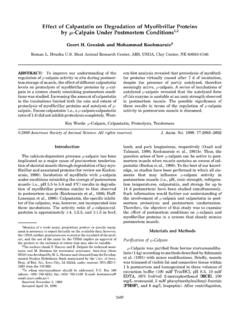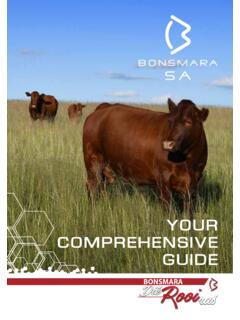Transcription of Net merit as a measure of lifetime profit: 2021 revision
1 Net merit as a measure of lifetime profit : 2021 revision VanRaden,1 Cole,1 M. Neupane,1 S. Toghiani,1 Gaddis,2 and Tempelman3. 1. Animal Genomics and Improvement Laboratory, Agricultural Research Service, USDA, Beltsville, MD 20705-2350. AIP RESEARCH REPORT. NM$8 (05-21). 301-504-8334 (voice) 301-504-8092 (fax) 2 Council on Dairy Cattle Breeding, Bowie, MD 20715. 3 Department of Animal Science, Michigan State University, East Lansing, MI 48824-1225. Overview | Updated economic values | Net merit calculation | Trait parameters | Expected genetic progress | Derivation of economic values | Feed saved | Maintenance | Feed cost | Heifer livability | Early first calving | Health traits | Fertility traits | Yield traits | Somatic cell score | Productive life/Cow livability | Type traits | calving ability | lifetime profit |.
2 History of net merit | Acknowledgments | Abbreviations | References Overview The lifetime net merit (NM$) index ranks dairy animals based on their combined genetic merit for economically important traits (Cole et al., 2021). Indexes are updated periodically to include new traits and to reflect prices expected in the next few years. This update of NM$ includes genetic evaluations for the new traits feed saved (FSAV), heifer livability (HLIV), and early first calving (EFC). Selection for these new traits will improve health and growth of calves and feed efficiency of cows.
3 The new FSAV evaluation includes the economic value of cow body weight composite (BWC) along with actual feed intake data from several thousand Holstein cows in and Canadian research herds. The trait residual feed intake (RFI) measures the difference of actual and expected feed intake. Relative economic values for BWC and RFI are presented separately because BWC is available for all breeds, whereas FSAV is available only for Holsteins. Now BWC gets more negative emphasis because of larger maintenance costs estimated from actual feed intake data.
4 The emphasis on BWC and emphasis on RFI combine for + emphasis on FSAV. Emphasis on the calving trait subindex (CA$) was reduced in August 2020 when the phenotypic bases and genetic standard deviations (SDs) were reduced for the four calving ease and stillbirth traits that CA$ includes. The CA$ subindex is not published directly. Total costs for six health traits are included in NM$ for Holsteins and Jerseys in the form of a health trait subindex (HTH$) that also is not published separately; the individual economic values within HTH$ have not changed.
5 Emphasis was reduced on udder composite (UDC) because recent gains in udder conformation have reduced the milking labor required and on feet/leg composite (FLC) because the linear traits are not well correlated with hoof health or lameness. Previous indicator traits can be replaced by direct income and expense traits if the indexes include sufficient data for the new traits. Emphasis on productive life (PL) was increased by accounting for profit from individual lactations instead of assuming constant profit across lactations.
6 Relative emphasis decreased slightly on cow livability (LIV) because death rates and cull cow prices declined. Relative emphasis on most other traits such as daughter pregnancy rate (DPR), cow conception rate (CCR), and heifer conception rate (HCR) decreased because of the inclusion of new traits. Other income or cost variables such as milk prices and feed requirements were updated. The 2021 and 2018 NM$ (VanRaden et al., 2018) indexes are correlated by for young Holstein bulls and for recently progeny-tested bulls.
7 Updated economic values New economic values for each unit of predicted transmitting ability (PTA) and relative economic emphasis of traits will be implemented in August 2021 for NM$, cheese merit (CM$), fluid merit (FM$), and grazing merit (GM$). Previous versions of NM$ reported relative values using the SD of true transmitting ability (TTA) but now report relative emphasis using the SD. of PTA. Relative value shows which traits are most important, whereas relative emphasis shows their contribution given their limited data and prediction reliability (REL) (Zhang and Amer, 2021).
8 Showing relative emphasis helps compare trait contributions to the ranking, whereas relative value better explains each trait's contribution to NM$ REL. This has no effect on the economic values or ranking and little effect on the reported emphasis because most traits have similar RELs, but the relative value of 14% for RFI was equivalent to only 4% relative emphasis because PTA for FSAV and RFI have low SD for young animals due to lower REL. The relative emphasis was calculated for young animals; progeny-tested bulls and cows have differing REL and emphasis.
9 Previously reported relative values are not directly comparable with the new relative emphasis values below. The traits are now displayed in the historical order that they were included in NM$: USDA ARR NM$8 1. Value ($/PTA unit) Relative emphasis (%). Trait Units SD NM$ FM$ CM$ GM$ NM$ FM$ CM$ GM$. Milk Pounds 567 Fat Pounds 25 Protein Pounds 15 PL Months 34 34 34 16 SCS 1. Log 74 42 95 78 BWC Composite 45 45 45 57 UDC Composite 19 19 19 23 FLC Composite 3 3 3 3 DPR Percent 11 11 11 34 CA$ Dollars 1 1 1 1 HCR Percent CCR Percent LIV Percent HTH$ Dollars RFI Pounds EFC Days HLIV Percent SCS = somatic cell score 1.
10 The SDs listed above are for PTAs of young bulls, whereas previous versions listed TTAs for a hypothetical unselected population. The SDs of TTAs for NM$, CM$, and FM$ are all estimated to be $234 and larger than the $197 for 2018 indexes (VanRaden, 2018), mainly because of the increased genetic variance from FSAV, decreased marginal feed needed for extra yield, and higher value of PL. The SDs for GM$ would be larger because of longer PL in grazing herds, except that milk yield differences are often reduced in such herds.


















